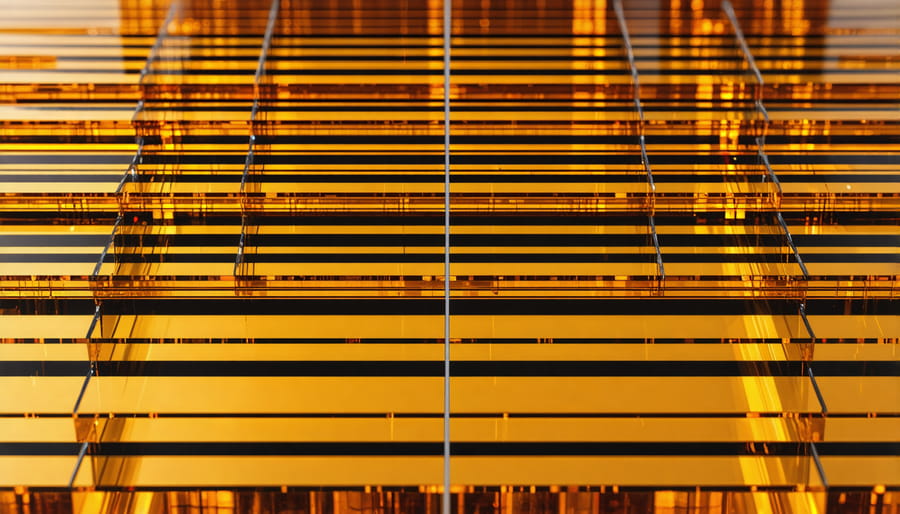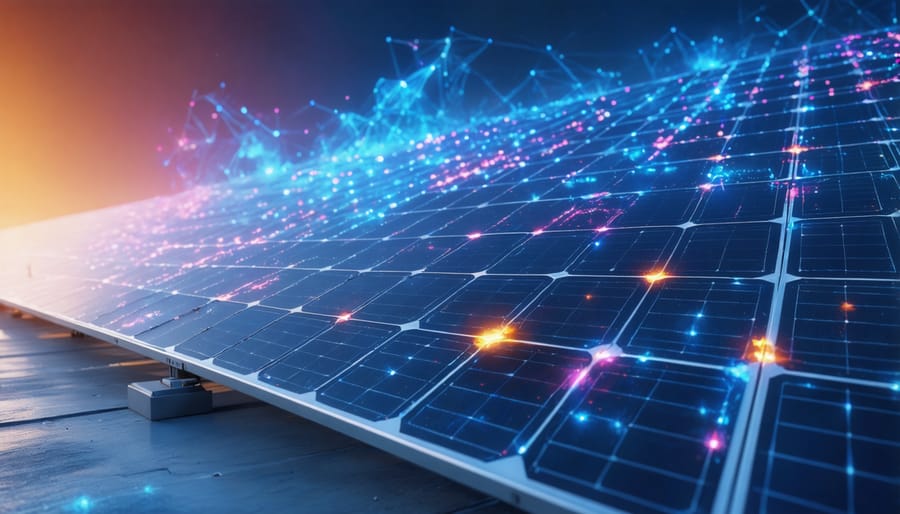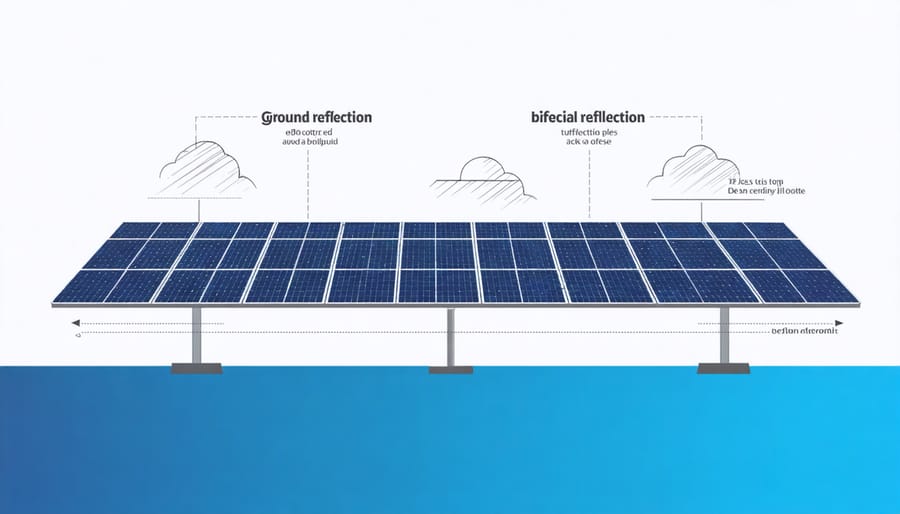Europe’s Solar Revolution: Groundbreaking Tech Reshaping Energy Production

Solar technology stands at the cusp of a transformative breakthrough, revolutionizing European energy production through groundbreaking innovations in efficiency and accessibility. Recent advances in photovoltaic materials have pushed solar cell efficiency beyond 45%, while drastically reducing production costs by 65% compared to just five years ago. These developments signal a pivotal shift in renewable energy adoption across the continent.
Perovskite-silicon tandem cells, nano-enhanced surface coatings, and bifacial panel technology are reshaping the solar landscape, offering unprecedented energy capture capabilities even in low-light conditions. This technical evolution, coupled with smart grid integration and advanced energy storage solutions, is enabling European businesses and homeowners to achieve energy independence while contributing to continental sustainability goals.
As we witness the convergence of artificial intelligence, Internet of Things (IoT), and solar technology, the future of clean energy has never been more promising. These innovations are not just improving performance metrics; they’re fundamentally changing how we harness, store, and distribute solar power across European communities.
Perovskite Solar Cells: The Next Generation of Solar Power

Enhanced Efficiency Breakthroughs
Recent enhanced efficiency breakthroughs in solar technology have pushed the boundaries of what’s possible in photovoltaic energy generation. The latest generation of solar cells now achieves conversion rates of up to 47% in laboratory conditions, marking a significant improvement over traditional panels that typically operate at 15-20% efficiency.
European researchers have made remarkable progress with perovskite-silicon tandem cells, which combine two different photovoltaic materials to capture a broader spectrum of sunlight. These innovative cells have demonstrated stable efficiency rates above 30% in real-world applications, making them increasingly viable for commercial deployment.
Breakthrough developments in anti-reflective coatings and light-trapping technologies have also contributed to improved performance metrics. New textured glass surfaces and specialized coating materials can now reduce light reflection by up to 99%, ensuring maximum solar energy absorption throughout the day.
Multi-junction cell technology has evolved to incorporate up to four layers of photovoltaic materials, each optimized to capture different wavelengths of light. This strategic layering, combined with advanced tracking systems, enables solar installations to maintain peak performance levels even in variable weather conditions and during different seasons.
These improvements translate to practical benefits for European consumers and businesses: smaller installation footprints for equivalent power output, reduced installation costs per kilowatt, and faster return on investment periods.
Commercial Viability Timeline
Recent advancements in solar technology are moving rapidly from laboratory success to market-ready solutions. Perovskite solar cells, one of the most promising innovations, are expected to enter commercial production by 2025, with several European manufacturers already scaling up their pilot facilities. The integration of these cells with existing silicon technology could reach mainstream markets by 2026-2027, offering enhanced efficiency at competitive prices.
Smart solar tiles and building-integrated photovoltaics (BIPV) are gaining traction in the European market, with full-scale commercial availability anticipated within the next 12-18 months. These solutions are particularly relevant for urban applications and heritage buildings where traditional panels may not be suitable.
Energy storage innovations, including advanced battery systems and thermal storage solutions, are projected to achieve cost parity with conventional systems by 2024. This timeline aligns with the EU’s renewable energy targets and growing market demand for integrated energy solutions.
Artificial Intelligence-driven solar management systems are already available, with more sophisticated versions expected to become standard features by 2025. These systems will optimize energy production and consumption patterns, potentially increasing overall system efficiency by 15-20%.
Manufacturing scale-up and supply chain optimization are expected to drive costs down significantly over the next three years, making these innovations increasingly accessible to both residential and commercial users. European initiatives and funding programs are accelerating this timeline, particularly in regions with strong solar potential.
Smart Solar Integration Technologies
AI-Powered Output Optimization
Artificial intelligence is revolutionising solar energy systems across Europe, enabling unprecedented levels of efficiency and performance optimization. Modern solar installations now incorporate sophisticated AI algorithms that continuously analyse multiple variables, including weather patterns, panel temperature, and historical performance data, to maximise energy yield.
These smart systems can predict optimal panel angles throughout the day, automatically adjusting tilt and orientation in advanced installations. By learning from historical data, AI systems can anticipate maintenance needs, detect potential issues before they become problems, and recommend cleaning schedules based on local environmental conditions.
In large-scale solar installations, AI-powered monitoring systems analyse performance data from thousands of panels simultaneously, identifying underperforming units and optimising power distribution across the entire array. This technology has demonstrated efficiency improvements of up to 20% in some European installations.
Machine learning algorithms are particularly effective at managing solar microgrids, balancing energy generation with storage and consumption patterns. These systems learn from usage patterns to optimise energy distribution, ensuring maximum utilisation of generated power while minimising waste.
For homeowners and businesses, AI-enabled solar monitoring apps provide real-time insights into system performance, energy consumption, and potential savings. These intelligent systems can even integrate with smart home devices to automatically adjust energy usage based on solar production forecasts, maximising self-consumption and reducing reliance on grid power.

Real-time Monitoring Solutions
Modern solar installations now benefit from sophisticated real-time monitoring solutions that transform how we track and optimize solar energy production. These advanced systems employ smart sensors and IoT technology to provide minute-by-minute performance data, enabling both homeowners and facility managers to maintain peak efficiency of their solar installations.
At the heart of these monitoring solutions are intelligent algorithms that analyse multiple parameters simultaneously, including power output, weather conditions, and system health indicators. Through user-friendly mobile apps and web interfaces, system owners can access detailed performance metrics and receive instant notifications about their installation’s status.
European solar monitoring platforms have particularly advanced in predictive maintenance capabilities. By detecting subtle changes in performance patterns, these systems can identify potential issues before they escalate into major problems. This proactive approach significantly reduces downtime and maintenance costs while extending the lifespan of solar installations.
For commercial installations, advanced monitoring solutions offer comprehensive reporting tools that facilitate compliance with European energy regulations and support green energy certification processes. These systems can automatically generate performance reports and calculate CO2 emission savings, making it easier for businesses to document their sustainability efforts.
The integration of artificial intelligence has further enhanced these monitoring capabilities, enabling automated performance optimization and more accurate energy generation forecasting. This helps system owners better plan their energy consumption and maximize their return on investment in solar technology.

Bifacial Solar Panels: Double-Sided Energy Collection
Bifacial solar panels represent one of the most significant advancements in photovoltaic technology, offering an innovative approach to solar energy collection by harvesting light from both sides of the panel. These cutting-edge modules capture direct sunlight on their front surface while simultaneously collecting reflected light on their rear side, substantially increasing their overall energy yield.
The technology’s efficiency gains are particularly impressive in European installations, where studies have shown energy yield improvements of 5-30% compared to traditional monofacial panels. This enhanced performance is especially notable in regions with high surface reflectivity, such as areas with snow cover, light-colored ground surfaces, or when installed over white roof membranes.
Several factors influence the performance of bifacial panels. Ground albedo (surface reflectivity) plays a crucial role, with snow offering up to 80% reflectivity and white concrete providing approximately 50%. Installation height and tilt angle also significantly impact energy collection, with optimal elevation typically ranging between 0.5 to 2 meters above the reflecting surface.
The technology proves particularly valuable in commercial and industrial applications, where large-scale installations can be optimized for bifacial collection. Vertical installations of bifacial panels are gaining popularity in agricultural settings, allowing for dual land use while capturing morning and evening sun from both sides. This configuration has shown remarkable success in European agrivoltaic projects.
Despite higher initial costs compared to traditional panels, the increased energy yield often results in a more favorable long-term return on investment. Modern bifacial installations typically feature advanced tracking systems and specialized mounting solutions that maximize the benefits of double-sided collection.
For European property owners considering solar installations, bifacial technology offers a forward-thinking solution that aligns with the continent’s ambitious renewable energy goals. The technology’s ability to generate more power from limited space makes it particularly attractive in urban and industrial environments where space optimization is crucial.
Energy Storage Innovations
Advanced Battery Technologies
Recent breakthroughs in battery technology are revolutionising how we store and utilise solar energy. The latest lithium-ion batteries specifically designed for solar applications now offer enhanced cycle life and deeper discharge capabilities, making them more reliable for both residential and commercial installations.
A significant development is the emergence of solid-state batteries, which promise greater energy density and improved safety compared to traditional lithium-ion solutions. These batteries operate efficiently at higher temperatures, making them particularly suitable for solar energy storage in warmer European climates.
Flow batteries are gaining traction in the European market, especially for large-scale solar installations. These systems can store massive amounts of energy and offer the unique advantage of independent scaling of power and energy capacity. Their long service life and minimal degradation make them cost-effective for industrial applications.
Smart battery management systems are another crucial advancement, optimising storage efficiency through artificial intelligence and predictive analytics. These systems can anticipate energy production and consumption patterns, automatically adjusting charging and discharging cycles to maximise solar energy utilisation.
For residential applications, compact modular batteries are becoming increasingly popular. These systems can be easily expanded as energy needs grow, offering homeowners flexibility and future-proofing their solar investments. Many now come with integrated hybrid inverters, simplifying installation and reducing overall system complexity.
Grid Integration Systems
Modern grid integration systems are revolutionising how solar energy connects with existing power infrastructure. Smart inverters now enable bi-directional power flow, allowing solar installations to communicate seamlessly with the grid while maintaining stable voltage and frequency levels. These advanced systems automatically adjust power output based on real-time grid conditions, ensuring optimal performance and reliability.
European utilities are implementing sophisticated monitoring and control platforms that enable precise management of distributed solar resources. These platforms use artificial intelligence and machine learning algorithms to predict energy generation patterns, manage peak loads, and balance supply with demand more effectively.
Virtual Power Plants (VPPs) represent another significant advancement, aggregating multiple solar installations into a single, controllable energy resource. This innovation enables smaller solar producers to participate in energy markets and grid services, creating new revenue streams while contributing to grid stability.
Grid-edge technologies, including smart meters and advanced distribution management systems, are enhancing grid visibility and control. These solutions enable grid operators to integrate higher percentages of solar power while maintaining system reliability. Real-time monitoring systems detect and respond to grid disturbances instantly, preventing potential issues before they affect power quality.
For European solar adopters, these integration innovations mean improved system efficiency, better return on investment, and enhanced grid reliability. The technology also supports the continent’s ambitious renewable energy targets while ensuring a stable and resilient power supply.
The rapid advancement of solar technology is reshaping Europe’s clean energy future in remarkable ways. From high-efficiency bifacial panels to innovative storage solutions and AI-driven optimization systems, these technologies are accelerating the continent’s energy transition. The impact is already visible, with increased adoption rates among homeowners and businesses, reduced installation costs, and improved grid integration capabilities. As these technologies continue to mature, they’re not just making solar energy more accessible and efficient but are also creating new opportunities for economic growth and environmental sustainability. This technological revolution in solar energy is proving instrumental in helping Europe achieve its ambitious climate goals while ensuring energy security for generations to come.
Leave a Reply